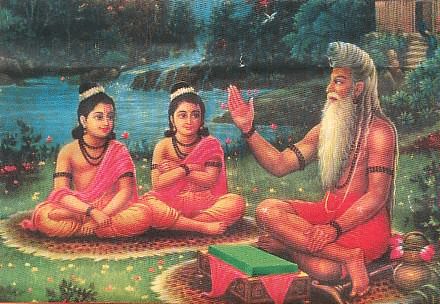In the Yoga Vashisht, Shree Raam receives knowledge on the nature of existence from the sage, Vashisht. Here are his teachings on the transformation of desire.
Guru Vashisht explained: “Vaasanaas or desires can be of two kinds: auspicious and inauspicious. If you are led by the stream of good desires, then you will gradually reach the eternal abode. However, if the disposition of the mind is bad, then it should be conquered by your own effort.” Good desires include studying scriptures to uplift oneself and performing service to society. Bad desires include wanting to harm others, or being destructive, greedy, cruel or egoistic. These qualities exist in all people. The reason they are put into action is only due to mental delusion or wrong thinking. We need to cultivate good vaasanaas consciously.
“The river of vaasanaas flowing through good and bad channels should be directed to the good channel by great effort.” There are strategies for pushing our desires in the right direction. There is the analogy that the river overflows its banks and there is water everywhere. Similarly, the uncontrolled flow of thoughts with negative desires leads one to destruction. How can the control of these negative desires be achieved? Firstly, by being intellectually alert as to what is happening in our own minds. Most people are not aware or do not have the time to analyse themselves or to take a step back when thoughts occur. Ask yourself, why am I thinking this? Why do I have this emotion? What is the root of it? Secondly, you can use analysis to self diagnose and identify the negative desires. The third method is by substitution: it means replacing the bad thoughts with a good one. One should replace the selfish thoughts with selfless thoughts. Instead of relentlessly chasing material things, turn the desire towards helping others.
The next method is by analysing what we have outgrown in life: what brings us joy as a child might no longer bring us joy as adults. Another way is by observing others: looking at what other people do and learning lessons; we should analyse the actions and reactions of people’s negative desires. The next strategy is by our own suffering or experience. By the path of karma yoga, selfless action we can exhaust these negative vaasanaas as well as through the paths of bhakti, love for the Supreme and humanity; gyaan, the path of knowledge and self enquiry; and dhyana, the path of meditation. Using these methods, or a combination, we can overcome our negative desires and turn them towards the positive side. In reality, there is one pathway that is tailored to our individual temperaments. Some might be more emotionally inclined and they are drawn to the path of bhakti yoga and some might be more intellectual so they are drawn to gyaan; however, each still values and incorporates elements of the other pathways.
Guru Vashisht then said, “Thereafter, even the stream of good vaasanaas should be abandoned, with burnt up passion, free from anxiety, and by realising the nature of reality.” When we have reached a state where there are only good desires in us, even they must be released.
In the final shloka, Guru Vashisht says: “At the gateway of liberation, there are four gatekeepers or guards on duty: control or quietude of mind, self enquiry, contentment, and association with the holy ones.” Quietude of mind means controlling our thoughts. Next, the intellect must be able to enquire into the Self. The third guard is contentment. One could be materially poor yet contented, or materially rich and unhappy. The last guard, the association of the good: without satsang (the association of the good), there cannot be discrimination between the real and unreal. If you practise quietude of mind, you will start to engage in self enquiry and associate with the good and find contentment. Similarly, if we practise any of these other methods, the others will follow.
On a practical level, whenever there is a desire, ask, is it a good or bad desire? If it’s bad, try to transform it into a good one. After a while, there will be only the desire to do good actions; then all desire will drop away. Only then will we reach the gateway to liberation.
Pt. Dr. Umesh Persad, Spiritual Leader, Gyaan Deepak Kirtan Mandali (from a Sunday morning service)



